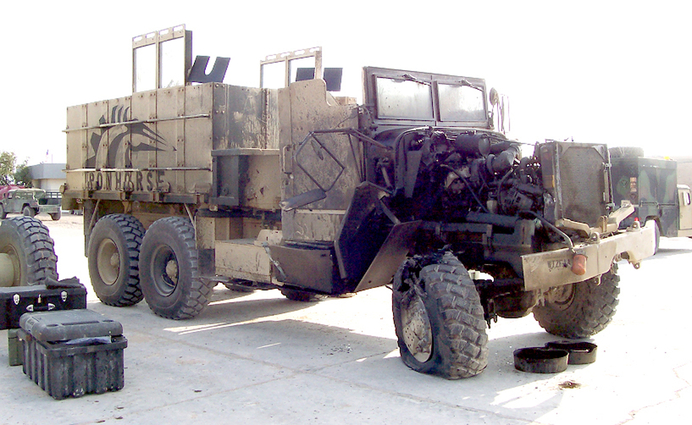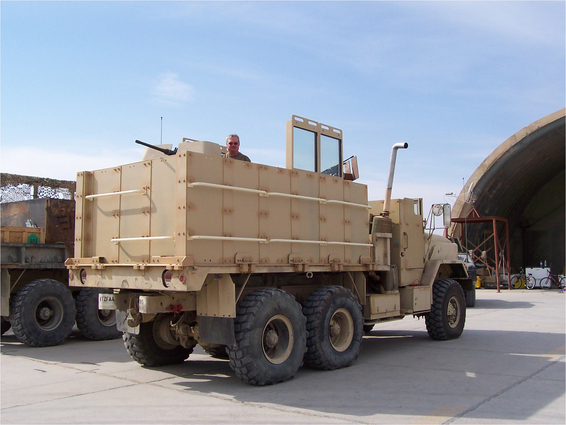Gun truck armor kits provide protection for U.S. troops in Iraq
WASHINGTON, D.C. — Under funding from the Defense Advanced Research Projects Agency (DARPA) and in collaboration with the U.S. Army, gun truck armor kits developed by Lawrence Livermore National Laboratory (LLNL) researchers are now providing convoy protection for American troops on the roads of Iraq.
Livermore researchers have created a modular, easy-to-assemble armor protection kit that, with the addition of several machine guns, allows the military to convert five-ton supply trucks into gun trucks to protect convoys.
To date, some 31 trucks have been outfitted with the armor protection kits and are being used in convoys on Iraqi roads, with plans for the assembly of dozens more gun truck kits in the near future.
In recent weeks, the U.S. Army has allocated $2 million and DARPA $1.5 million to permit the production of gun box armor kits for 80 more trucks.
The House Armed Services Committee Chairman, Rep. Duncan Hunter (R-Calif), asked the Laboratory to develop modern gun truck armor kits.
At a demonstration of the armor kits today, Hunter praised the "great talented folks" at LLNL who developed the armor kits that helped protect seven soldiers traveling in an Iron Horse truck that was "hit by a major IED (improvised explosive device) – a huge blast. The driver sent back a message, ‘All seven are breathing today,’ and sends his thanks," Hunter said.
"We wanted to address the main threats of hidden bombs or improvised explosive devices, sometimes followed by ambushes," said Milt Finger, former head of Department of Defense programs at LLNL, who oversaw the program for the Laboratory. "We have sought to protect the truck occupants from the initial blast and give them stronger convoy protection."
The gun truck kits have proven popular and helpful to American soldiers in Iraq – so much so, that one transportation battalion (which has received most of the gun truck kits) has given LLNL a commendation "for exceptional service."
Each gun truck kit, which consists of readily available and low-cost armor steel and ballistic fiberglass panels, provides a wall of protection around the back of the truck and for the truck cab. Each side wall is topped by two-foot by two-foot sections of transparent armor to protect machine gun operators (gun trucks usually carry two to four machine guns).
Gun trucks offer several advantages over other vehicles. They can carry more armor because they are heavy vehicles; the truck’s elevation provides good vision and better protection from IED threats; and the vehicles have multiple guns in the event one gun jams or the truck is attacked from multiple directions, Finger said.
Finger sees a number of other benefits provided by the Livermore gun truck kits. In addition to having a simple design and ample ballistic protection, the kits are relatively inexpensive ($40,000), can be assembled by a team within five hours and are easy to repair.
"Everyone on the LLNL team felt privileged to be able to have an impact in protecting our troops overseas. We all felt the gun trucks would be very useful and be well-received by the soldiers," Finger added.
"We pushed hard to provide a rapid response to this need that was identified to us by the military and government officials," Finger said.
After the need was identified, a team of Lab researchers started meeting at once, settled on plans for building gun trucks in January 2004 and started design work in February.
The first prototype gun truck, built by the shops of the Lab’s Manufacturing and Materials Engineering Division, was completed in March 2004 and sent to the U.S. Army Developmental Test Command’s (DTC) Aberdeen Test Center at Aberdeen Proving Ground in Maryland for ballistics and safety testing.
Working double shifts to quickly gather and analyze test data, DTC provided advice on armor performance, along with safety fixes and recommendations on design improvements.
The prototype truck was shipped to Iraq in July 2004 to a transportation battalion at Camp Anaconda in Balad, north of Baghdad. The truck proved popular with the soldiers and was used on daily missions.
Later, the military requested 30 more gun truck kits and those kits were shipped to Iraq, arriving in December 2004. Lab teams have twice visited Iraq to provide instructions on assembly procedures and to receive additional first-hand feedback.
After LLNL built the first prototype truck, the technology was transferred to U.S. companies for production. The project’s main contractor was Plate Fabrication and Machining of Philadelphia, Pa., and two other firms – Waco Composites of Waco, Texas, and Protective Armored Systems of Lenoxdale, Mass. – have been key participants.
In addition to Finger, LLNL researchers on the team are Steve DeTeresa, project leader for the truck kit, mechanical technician Walter Grundler, and machinist Mike Thiry. Other team members from outside the Laboratory are Vietnam-era gun truck veterans Larry Fiandt and James Lyles, and engineer Phil Sluder.
Gun trucks were used during the Vietnam War. In developing the new gun truck kits, the LLNL researchers used information from the Vietnam-era gun truck veterans and designed upgrades to reflect the differences in the Iraq war.
"The multidisciplinary nature of the Laboratory allowed us to respond quickly to Rep. Hunter’s request and to do so successfully," DeTeresa said. "The troops have really loved these armor kits. They have gotten all kinds of accolades."
The Lab employee also credited the staff of the Aberdeen Test Center and the Tank and Automotive Command with providing "excellent support and feedback" toward making the gun trucks.
Founded in 1952, Lawrence Livermore National Laboratory has a mission to ensure national security and apply science and technology to the important issues of our time. Lawrence Livermore National Laboratory is managed by the University of California for the U.S. Department of Energy’s National Nuclear Security Administration.
Contact
Josh Holly202-225-2539
Related Links
LLNL’s Manufacturing and Materials Engineering Division“Leveraging Science and Technology in the National Interest”







